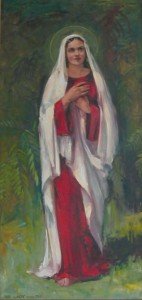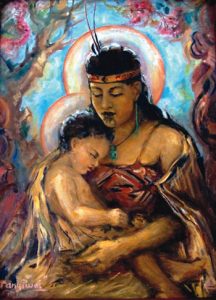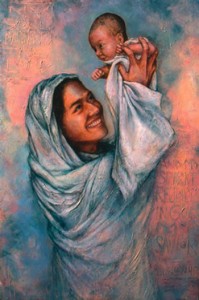Mary for Today – Mary for the Third Millennium (3)
Given the directions outlined in Pope Paul VI’s Marialis Cultus, I will continue to develop the lines he recommended.
Mary and Liturgy
This has been another area of significant change. The numerous feast days of Mary, some with a very doubtful historical basis, have been trimmed. Those left, and even those added to the liturgical calendar, such as Mary, Mother of God, on January 1st, have taken on greater significance. In the past, when the congregation felt excluded from worship because of language and a liturgy that was more the work of the priest than the people, devotions such as rosaries and novenas filled a spiritual gap. Today such practices are to be left outside the central act, the source and summit of the worship of the Church, the Eucharist. Such practices from the past “create the danger that the Lord’s Memorial Rite, instead of being the culmination of the meeting of the Christian community, becomes the occasion, as it were, for devotional practices” (Marialis Cultus #31). “It is a mistake to recite the Rosary during the celebration of the liturgy, though unfortunately this practice still persists here and there” (ibid #48).
Many devotions have been in decline over the last 45 years, and this has been the most noticeable area of pain. Marian theology has been enriched but devotion has been depleted. It is here that change has most impacted on Catholic consciousness and sensitivities. We need to be clear that devotions, for that is what they are, have always been a matter of personal preference, but Eucharist is a communal exercise. In the past Marian devotions filled a role that liturgy should have filled in the lives of people.
Mary and Devotions

Our Lady of the Tui, Julia B Lynch, Sister Mary Lawrence. The original is at Holy Cross Seminary, Auckland, NZ
How are we to express our love and veneration for Mary? We have grown up with litanies, rosaries, novenas, and a lot of popular prayers. Marian piety was characterised by novenas and prayers to obtain favours, good in themselves, but running the risk of superstition, and using Mary as a grace dispenser rather than a total person. Devotion to Mary goes beyond simply asking for heavenly favours. We have the words of Pope John Paul II from his address of October 29th 1997, “Let the faithful remember that true devotion to Mary consists neither of fruitless and passing emotion, nor in a certain vain credulity. Rather it proceeds from true faith, by which we are led to know the excellence of the Mother of God, and are moved to a filial love toward our mother and to the imitation of her virtues” (cf. Lumen Gentium #67). He went on to comment that “believing everything and sentimentalism” are obstacles to authentic Marian devotion, words aimed at discouraging idle speculation about stories of apparitions, which had become common in recent years.
The true test of devotion to Mary, the pope said, lies in the effort to imitate her virtues.
We need to recognise that genuine Mariology is a matter for both head and heart. There is no room for a piety that neglects study or a study that neglects piety. In the Eastern world, one was not a theologian unless one was first a mystic. The great Benedictine ideal is the love of learning and the desire for God; this produced some of the greatest saints and greatest devotees of Mary. When you read through a series such as this, both head and heart are engaged. My hope is that you come to learn to value and understand Mary more. You seek sources to enrich your love for Mary. You seek to know what might be the current thinking and writing in the Church on Mary. You cannot know a person until you know about that person.
Mary and Anthropology
Often in life we find ourselves challenged by entering the culture of another people, when we step outside our own culture to experience another’s. No culture is perfect, but it can be a source of enrichment for life. It is also an important aspect of reading the Bible with an awareness that it came from a culture very different from our own, the Mediterranean culture of the early first millennium. It is an easy temptation to read the Bible through the eyes of our own cultures, and not appreciate some of the more significant cultural elements of the time of Jesus and Mary.
The Philippines brought home to me the challenge the Gospel is to culture. My first experience of the Feast of the Santa Nino was at Mass standing between two street children. I could not but contrast the state of these children of flesh and blood with that of the richly clad child of the devotion. One can honour some cultures for their deep devotion to the Madonna and child, but the poor children of the country must surely tear at the heart of our good Mother Mary. When apparitions of Mary speak of the pain of such children, living in the misery of such places as the Payatas rubbish dump of Manila, and then mobilise the whole Church to action, we may well hear of a mother within the Church, not above or outside of it. A prophetic role within culture may well be the future Mary.
Mary in her Magnificat
Women have shared the experience of being among the most poor and economically oppressed. Mary is a symbol of the work for social justice, especially through her powerful song of social protest, the Magnificat. The Latin American Bishops at Pueblo warned us that “It is a betrayal to interpret this prayer (only) at a spiritual level”. It is a call for action on behalf of marginalised and exploited people. She is the prophet of the poor, representing their hope as a woman who has suffered and been proved in the right. This all reminds us of the great apparition of Guadalupe, where Mary appeared as one concerned for the poor and oppressed among her people.

Tangiwai, Julia B Lynch, Sister Mary Lawrence. The original is at Hiruharama Church, Whanganui River, NZ
Further cultural questions are raised by the recognition of the humanity and Jewishness of Jesus and Mary. A rather sobering question recently asked is whether the Christian neglect of the essential Jewishness of Jesus and Mary in any way contributed to the death of six million Jews in Nazi Germany (a predominantly Catholic and Lutheran country)? Geva Vermes’ Jesus the Jew (1973) was the first to tackle seriously such a presentation. Why in the Philippines did Catholics have such difficulty in accepting Mary portrayed as a Filippina, for as a Jewish woman, she would have more closely resembled one of them than the white European portrayals that we are used to? The insistence of Bishop Yap in 1954 for a change produced the beautiful picture of Our Lady of the Barangay. Is this still a hangover from the colonial era? How do we react to that beautiful Maori Madonna?
Does the portrayal in art of a European Madonna touch in to cultural values such as beauty and power, Mary as the most beautiful and powerful of w
Given the directions outlined in Pope Paul VI’s Marialis Cultus, I will continue to develop the lines he recommended.


 Entries(RSS)
Entries(RSS)